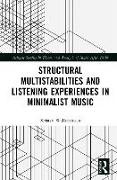Ulteriori informazioni
Kristen Wallentinsen uses an interdisciplinary theory of multistability to investigate different effects minimalist music has on the listener.
Drawing on theories of multistability from philosophy and psychology, the book builds an analytical framework and typology that demonstrates minimalist music's reliance on multistable structure for its interpretive flexibility. Through a close analysis of works by Steve Reich, Philip Glass, Meredith Monk, Ann Southam, Charlemagne Palestine, and Julius Eastman, the book shows that multistability exists as a through-line across minimalist compositional approaches and can be a valuable way to gain deeper insight into the structures and experiences of minimalist music.
This book will be of primary interest to scholars of music theory and musicology, but will also be of interest to scholars of music cognition, music performance, philosophy, art, and media studies, as well as those interested in twentieth-century culture. It benefits readers by introducing an interdisciplinary approach to the analysis of listener experience in music.
Sommario
Chapter 1: Intentionality and Flexibility in Minimalist Music Chapter 2: "Mysteries to Satisfy All": A Cognitive and Phenomenological Frame Chapter 3: A Typology of Multistable Phenomena in Minimalist Music Chapter 4: Realizing Multistability in Minimalist Music: Parametric Interaction Chapter 5: Ambiguity and Multistable Experience in Reich's The Desert Music Chapter 6: Jugglers, Dancers, and Filmmakers: Multistability's Interactions in Minimalist Multimedia Compositions Conclusion: A new element of shared minimalist aesthetic?
Info autore
Kristen Wallentinsen is an Assistant Professor of Music Theory at Rutgers University's Mason Gross School of the Arts. Her current research draws on phenomenology and music perception to explore ambiguities in the perception of patterns that emerge from the repetitive fabric of minimalist music. Her other research interests include music perception and cognition, music theory pedagogy, melodic contour, and the intersections of music theory and mathematics.

